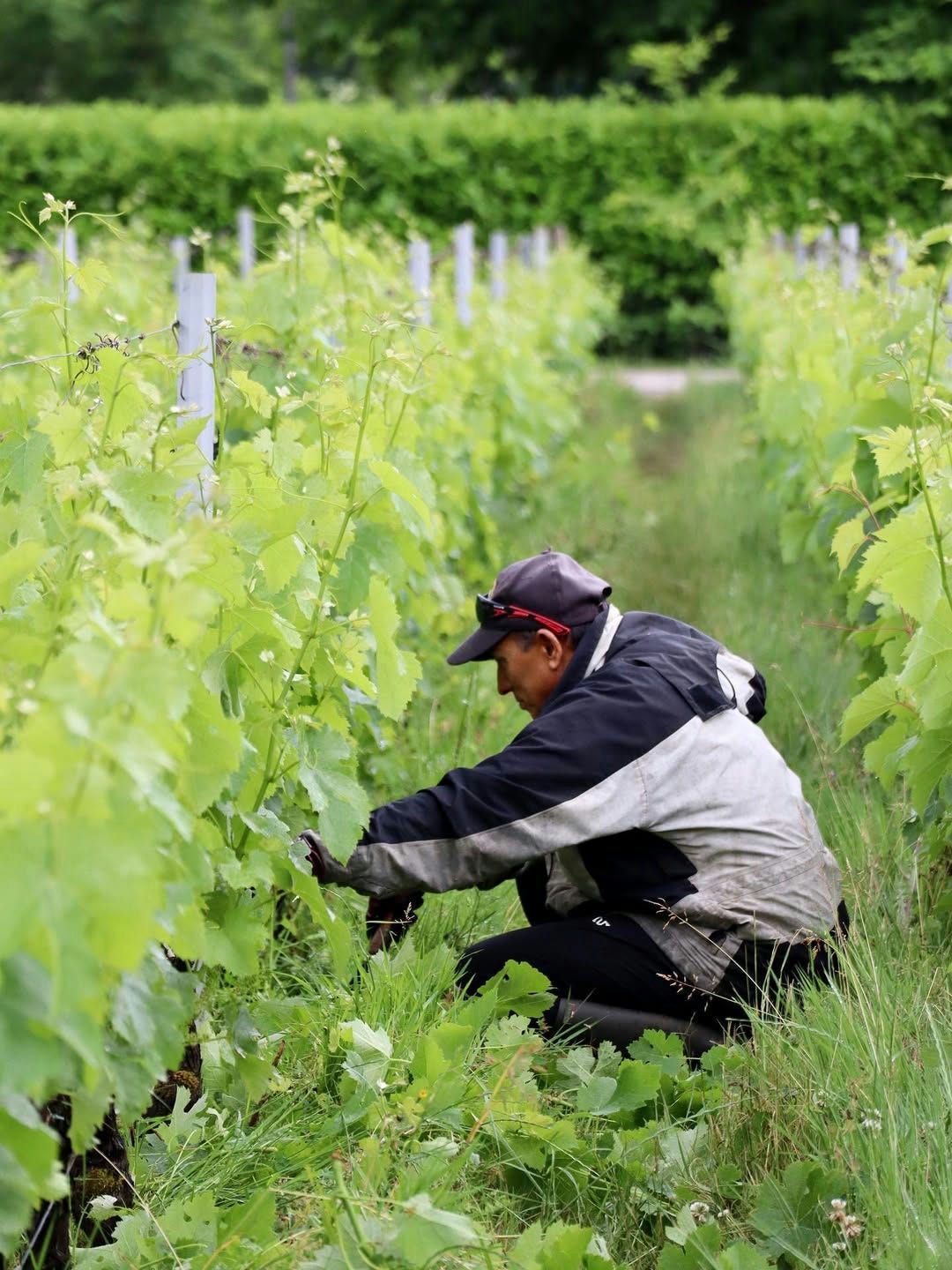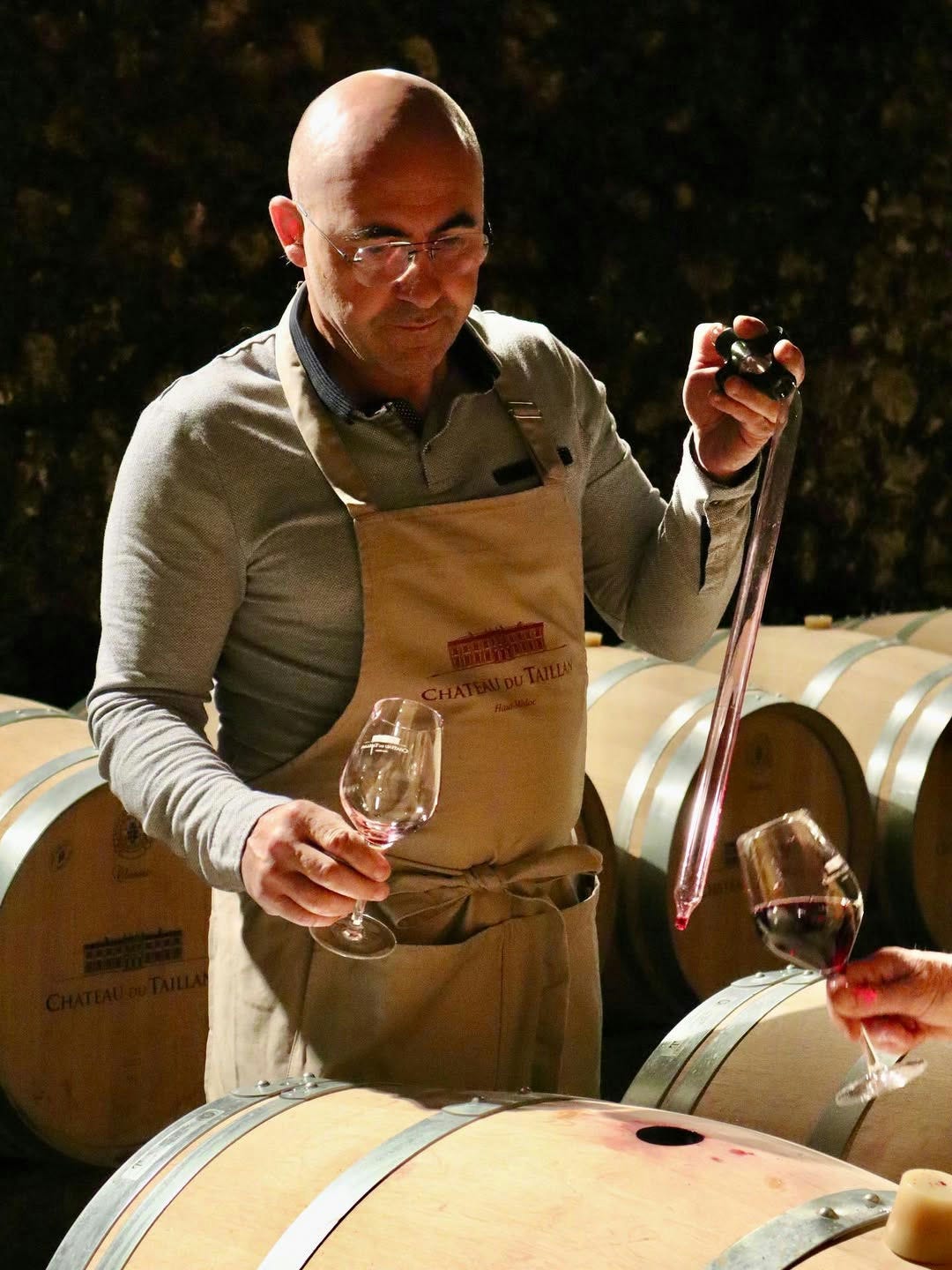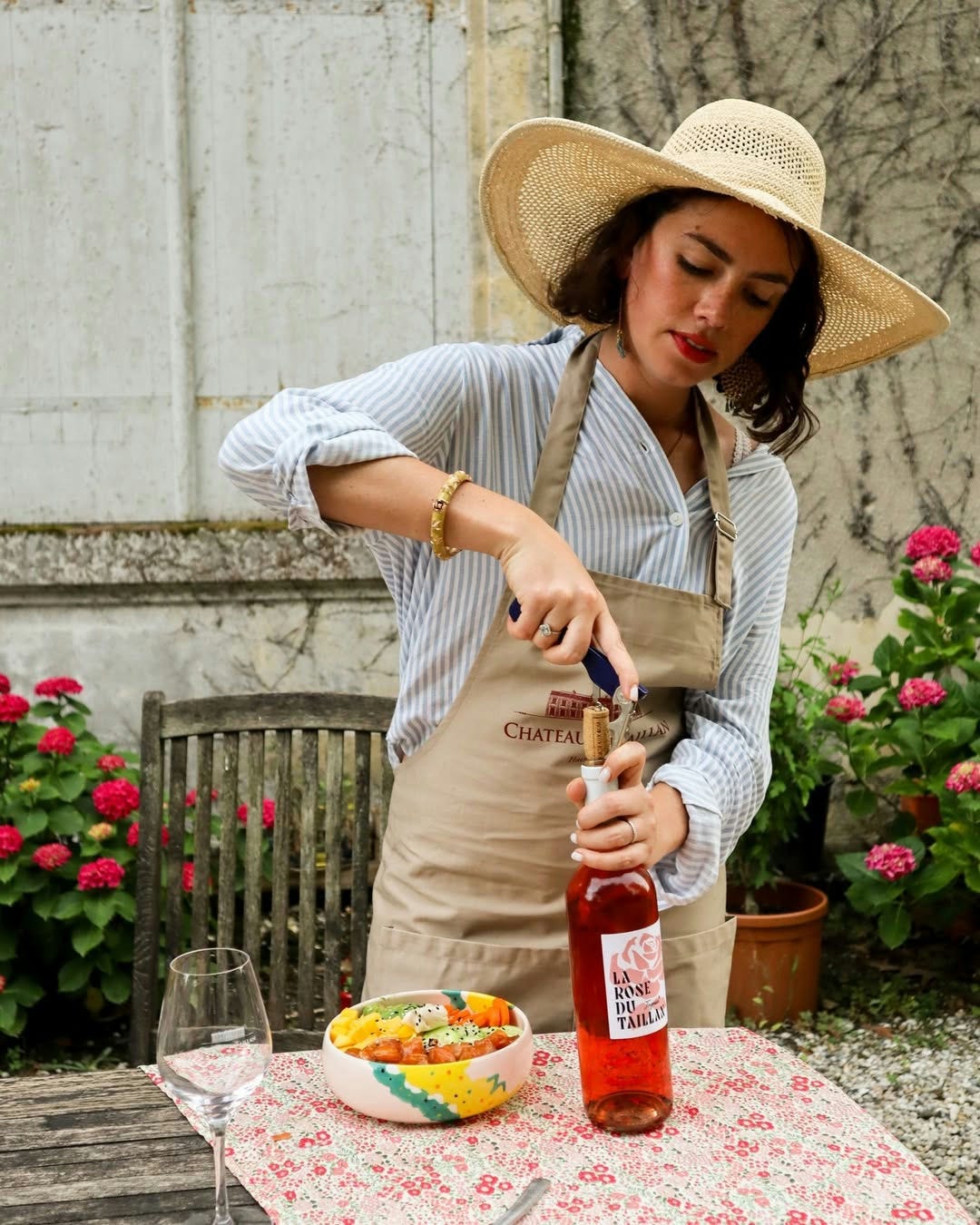In 1797, Alfred Flinoy, a French trader, snapped up a castle badly damaged during the French Revolution. Sacked and crumbling, the château needed serious work. But more than 100 hectares of grains, woods, and vineyards dating to the twelfth century promised to pay the bills.
Sixty miles from the Bordeaux coast, Château Castelneau and its vineyards passed through eight generations of Flinoy’s family. Those eight generations produced consistently good table wines—a well-respected, wholly unremarkable operation.
In 1988 the merchant’s great-great-great-great-great-great grandson, Loïc de Roquefeuil, moved in. De Roquefeuil found “extraordinary joy” in taking over the estate, he said. He and his wife Diane renovated Castelneau’s cantina and built up a rigorous schedule of tastings and events. They had four children, while nudging production of the family’s Bordeaux reds and whites north of 200,000 bottles a year. (Not unrelatedly: “More wine helps people to make more children,” de Roquefeuil told me.)
During the pandemic de Roquefeuil, now 73 years old, began to talk to his children in earnest about succession. “We have worked this land for nine generations,” he said. “I wanted to arrive at the tenth.”
The junior de Roquefeuils gave him an unequivocal answer: “It is too complicated; it is not lucrative enough; we will not take Castelneau over. Papa, you have to stop.”
So effectively, he has.
Because there is an enormous oversupply of French wine, the government has been paying farmers who uproot their vineyards. Diane and Loïc de Roquefeuil have, in the last two years, destroyed 30 hectares of their family vineyard’s 36. The future of those fields are uncertain—maybe, de Roquefeuil said, he’ll plant sunflowers, wheat, or maize.
I sat with de Roquefeuil, an impish man, in Castelneau’s rosemary garden on a sunny day earlier this month. Fallow fields stretched out behind us. He swept an arm toward them. “It’s all over,” he said. Tears welled up behind his glasses.
De Roquefeuil has company. Worldwide, so many things seem to be conspiring against the French wine industry. There is climate change, and a drastic slide in wine consumption has sent the industry spinning into freefall. And most recently, there are the Trump administration’s tariffs, which will undoubtedly cut into French wine sales in the U.S.
In France, the beginnings of the crisis—the much-discussed crise viticole—led families like the Roquefeuils to close one in six vineyards between 2012 and 2022. Since then, things have only gotten worse.
Young people drink less than any generation before them. When they do indulge, they prefer nearly anything—beer, hard seltzers, light and sparkling wines—over the powerful, tannic reds for which Bordeaux is known.
Half of French winemakers will retire in the next 10 years, and there are not enough young people willing to replace them. Across Bordeaux, France’s largest wine-growing region, thousands of small-scale chateaux are in “alarming, explosive” financial straits, per France’s Independent Winemakers’ Association. Big money players—hedge funds, sports stars, billionaires—are swooping in to buy out their struggling owners. Many of them will use the vineyards as a retreat or a second home rather than a place that produces wine. Others are also bringing about market consolidation, industrialization, and a cash infusion that Bordeaux’s wine industry needs to stay alive.
But its human cost is radical disruption to a region’s way of life. Winemakers are staring down the end of their centuries-old tradition.
The Garonne and Dordogne rivers deposit gravel and clay—catnip for grapes—through Bordeaux, a green, hilly region on France’s southwestern coast. The bulk of French Premier Cru Classés, the country’s superluxe wines, come from vineyards sprinkled throughout the region that were sold in the last 50 years to fashion conglomerates and billionaires. But two thirds of Bordeaux’s vineyards are outfits like the de Roquefeuil’s: family-run, fourth- or fifth- or ninth-generation châteaux making merlots and cabernets for between 5 and 45 euros a bottle.
The mystique of the industry’s key terms—France, wine, châteaux—lead his clients to register surprise when they visit Bordeaux at “how modest it is,” Tim Crakes, a senior wine importer at New York’s Morrell and Company, told me. “I respond with: Yeah. It’s agriculture.” De Roquefeuil called running a family vineyard a “school of humility.”
And that was before drought, hail, wildfires, and frost in recent decades blighted harvests from Patagonia to Napa Valley to Bordeaux—crises for vineyards that, like most small agriculture, survive harvest to harvest. Warming temperatures cause grapes to ripen more quickly, throwing off the delicate chemistry of wine that does make it into the cantina. Sugar levels rise; acid levels drop. “Those wines may taste great for their first five, six years of life,” said Crakes. “But they’re not going to last for the 50, 60, 100, 200 years that great vintages are known for.”
Then there’s the problem of wine consumption, which fell last year to its lowest worldwide level since 1961. That’s for two reasons. One: Older wine loyalists are pulling back on spending. “If you buy a 2023 vintage, and see that wine might outlive you,” said Crakes, “that’s not a feeling you want to bring home.”
And two: Young people drink less than any generation before them. When they do indulge, they prefer nearly anything—beer, hard seltzers, light and sparkling wines—over the powerful, tannic reds for which Bordeaux is known. Gen Zers and millennials have proven themselves less interested in exploring and learning how to pair wines than they are, say, in an Instagrammable label.
Winemakers mutter darkly about French youths’ growing affinity for tapas and happy hours and finger food—all international imports, elders say, that splinter the tradition of family around the dinner table, pairing cheese, meat, and red wine.

Finally, there is the 15 percent tariff the European Union just agreed to pay as part of a new trade agreement with the Trump administration. France exports 19 percent of its wine to the American market, so tacking on an extra 15 percent to the price will hurt—even though it could have been worse, with Trump threatening a 30 percent tariff. “It’s more than 10 percent but less than 30 percent,” sighed Armelle Cruse Falcy, the fourth-generation owner of Château du Taillan. “It’s less than expected but still too much. It complicates things for us. We really did not need this, but we will have to make do.”
Altogether, said Thomas Le Grix de la Salle, another fourth-generation winemaker, their children can see the industry contracting. They make the pragmatic choice to walk away. “Young people say: ‘I can have an easy job in Paris, in finance, I can make 15,000 euros a month; I’m not going to force myself to work like a dog to scrape together 2,000 euros a month.’ ”
Falcy, 61, oversees Château du Taillan’s 26-hectare vineyard. “My challenge for many years was to cultivate, manage, do quality control, balance the books,” she told me. “Today the challenge is to practice the trade—and then go to battle with the environment, to find new products to reengage consumers, to reinvent yourself completely, to be hugely creative. Then you might stand a chance.”
For her, creativity looks like a full slate of vineyard summer weddings, a menu of tasting itineraries for tourists, and a new line of wine, precision-designed to trick young people into going home with a Bordeaux. La Rose du Taillan, which retails for between 10 and 12 euros a bottle, comes in red, white, and rosé. It ditches Château du Taillan’s staid castle-and-serif label for a stylized flower and an off-center, funky font. Le Taillan’s website suggests drinking the line’s fruity rosé with Thai salads or poke bowls.

After I interviewed Cruse Falcy I had lunch in Le Taillan’s sun-drenched country kitchen with Guillemette, the Cruse family’s 90-year-old matriarch, and Tatiana Falcy, 28, Armelle’s youngest daughter. We all drank Taillan’s classic red. Guillemette plated a Camembert and ate steak haché, France’s hamburger patty, raw. “Mamie,” said Tatiana, “we’re developing a new line: boxed wine, three liters. A rouge frigo. A fridge red.”
Guillemette’s fork froze in midair. “A fridge red,” she repeated, slowly. “How strange. Imagine that.”
Tatiana, who has worked full-time at Le Taillan since 2022, is the exception to the rule that the children of winemakers would prefer to be investment bankers in Paris. I asked Tatiana if she could refer me to anyone else around her age still involved with a family vineyard. “I think I am alone,” she said.
Her two sisters and 10 cousins, each with an equal share in the family business, have steered clear of wine. They work in London, Paris, and the city of Bordeaux, in finance, fashion, and hospitality. Tatiana meant to follow them. In 2020, like an increasing share of France’s educated youth, she was set to move abroad, to New York. Covid and closed borders stopped her. Stuck at home, she took charge of Le Taillan’s social media. Then she got to work on hospitality, tasting, and events. “It wasn’t a calling,” she says now. “It was by chance, it was natural.” Slowly, “my passion for the region, for my mother, for loyalty,” won her over.
Tatiana, who is slight, dark-haired, and blue-eyed, is downright fierce on the subject of her decision. “The worse it goes for us, for wine, for Bordeaux, the more I want to work for this cause,” she said. “Here we have something more than marketing: ancestral savoir faire, tradition, prehistory. And I don’t think tradition should be thrown in the trash.”

To the Bordeaux winemakers watching their industry implode, that is what makes their style of business worth defending. Le Grix de la Salle, 47, runs the Château Le Grand Verdu’s 120-hectare vineyard with his brother, Édouard. “Clearly if the ledgers are negative for 15 or 20 years I will tell my children: We all tried, it’s too hard, we’ll sell. That’s possible. But we’ll fight so that it doesn’t end that way.”
It comes down, Le Grix de la Salle said, to nothing less than the meaning of a life:
Is succeeding in life having 10 apartments and four beautiful cars and eating in five-star hotels? I don’t know. My model is humility, simplicity, passion, heritage, and knowing how to be happy with that, being happy just to pass down what we’ve received. What did I do in my life? I received and I handed down the family property. That has inestimable value.
To some Bordeaux natives, the invasion of the asset managers and insurance companies who are sweeping to buy their agricultural heartland is unequivocally evil. Around the region xeroxed signs demanding its readers to “protect our traditions” cover telephone poles. Handing winemaking to a conglomerate pains Le Grix de la Salle: “They have one sole objective: profit. We have one sole objective: quality. The day this does not go well they will sell and invest that money in automobiles or jewelry. This is not our job here. This is our life.”
But to Crakes, the issue is more complicated. “Any concept of a small business going under is sad—especially a small business that has been in a family for generations,” he said. “But with regards to the trend of demand versus inventory—I don’t want to sound insensitive here—you could turn the tap off on every winery in the world today and there would still be enough to go around for decades. And in this business, as in any business, you adapt, you innovate, or you die.”
A billionaire buying up a family vineyard does not always mean the end to a trade, or a tradition. Jacky Lorenzetti, the Swiss billionaire owner of one of France’s top rugby teams, has made a name for himself as an angel investor in Bordeaux châteaux—keeping family winemakers in place and injecting cash to buoy their struggling operations. One of those châteaux, Château d’Issan, belongs to Armelle Falcy Cruse’s relatives. “Nothing will change with the day-to-day running of Issan,” her distant cousin, Emmanuel Cruse, told press after the sale in 2013. The deal “will enable me to work alongside a shareholder who has equal belief in my strategy, and who has a vision to push things forward.”
At Château du Taillan, I asked Cruse Falcy what she meant by “looking for solutions.” What kinds of offers—from multinationals, sports stars in the market for summer homes, investors like Lorenzetti—had she received, and was she considering? “Don’t take notes,” she said, and proceeded to tell me.
Click this link for the original source of this article.
Author: Josephine de La Bruyère
This content is courtesy of, and owned and copyrighted by, https://bariweiss.substack.com feed and its author. This content is made available by use of the public RSS feed offered by the host site and is used for educational purposes only. If you are the author or represent the host site and would like this content removed now and in the future, please contact USSANews.com using the email address in the Contact page found in the website menu.







